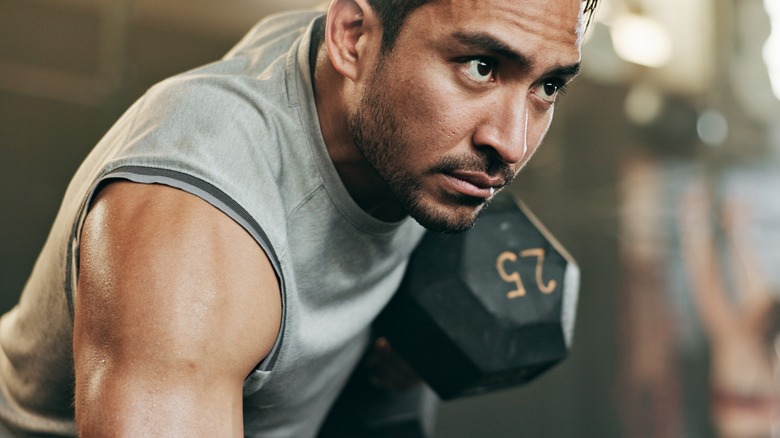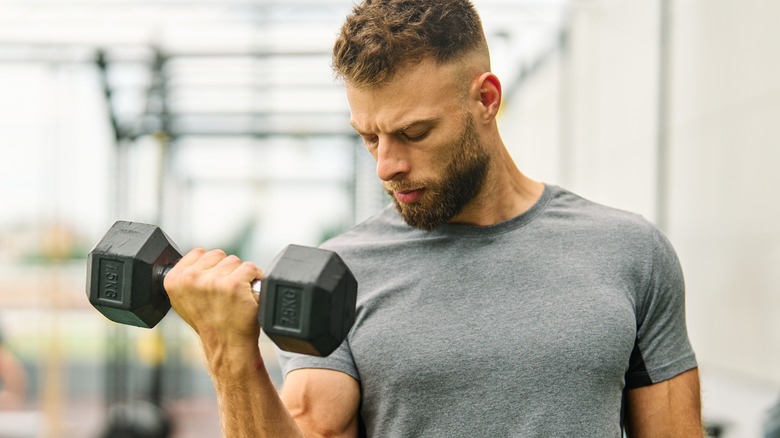Why Lifting Weights Can Increase Your Risk Of Hemorrhoids (And How To Prevent It)
While they're seldom a serious cause for concern, hemorrhoids can nevertheless cause the sufferer an annoying level of discomfort or irritation, especially when they're trying to do their business in the bathroom. Per Healthline, there are four kinds of hemorrhoids – internal, external, prolapsed, and thrombosed — and all of them involve swollen veins in your anus or rectal region.
There are a number of reasons why hemorrhoids may develop in your body. Lifting weights is perhaps one of the most commonly associated factors, which is a bit of a misconception; it's not the heavy lifting that causes hemorrhoids per se, but heavy lifting with improper form (which is more likely to happen when you're lifting weights that are too heavy for you) or breathing techniques (e.g., holding in your breath), via GoodRx Health. Other factors are lifestyle-related, including obesity, fiber deficiency, or pregnancy.
As Dr. Raj Dasgupta, Chief Medical Advisor for Fortune Recommends Health, tells Health Digest, "Both men and women can get hemorrhoids, especially if they strain during bowel movements or don't eat enough fiber."
Are men at greater risk?
With that said, lifting heavy weights does have a degree of impact on one's hemorrhoid risk. You may not notice it, but when you lift something heavy, you're likely to simultaneously hold your breath and exert additional effort. This results in additional pressure on your organ systems (as the air in your lungs gets pushed down), subsequently causing swelling in the veins in your anal region. This is why straining while you poop is equally bad for your hemorrhoid risk: both entail pressure building up in your abdomen (per GoodRx Health).
According to Dr. Raj Dasgupta, because men are more likely to lift heavy weights than women, they are "slightly more at risk for hemorrhoids." However, he is quick to clarify: "Lifestyle choices have a bigger impact on the risk than gender alone." Indeed, a 2021 study in Frontiers in Surgery found that aside from additional intake of dietary soluble fiber, beneficial lifestyle changes (e.g., improved hydration, consistent physical activity, better hygiene in the rectal region) may help patients with hemorrhoids.
How to lower your risk of hemorrhoids when lifting
Fortunately, you don't need to stop lifting weights if you're afraid of getting hemorrhoids. Dr. Raj Dasgupta has some helpful tips when it comes to both preventing and dealing with hemorrhoids while living an active lifestyle. "To lower the chances of getting hemorrhoids when lifting weights, avoid straining or holding your breath during lifts," says the quadruple board-certified physician. "Use proper form, lift weights you can handle, and increase the intensity slowly. Adding low-impact exercises like swimming or cycling can also help. Staying hydrated and eating enough fiber can prevent constipation, which can make hemorrhoids worse."
On the other hand, if you're already suffering from hemorrhoids, Dasgupta recommends modifying your workout plan and leaving out exercises that involve heavy lifting, so as not to exacerbate your condition. "Focus on low-impact exercises and help your body heal by eating a fiber-rich diet, drinking plenty of water, and not straining in the bathroom," advises the doctor. Then, after you recover from your condition, you can gradually incorporate lifting into your workout routine once more; just make sure that you're making an effort to stick to proper form and breathing techniques.


